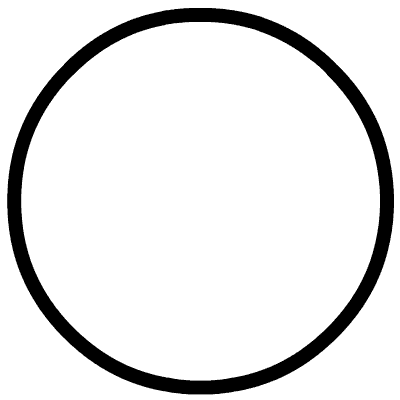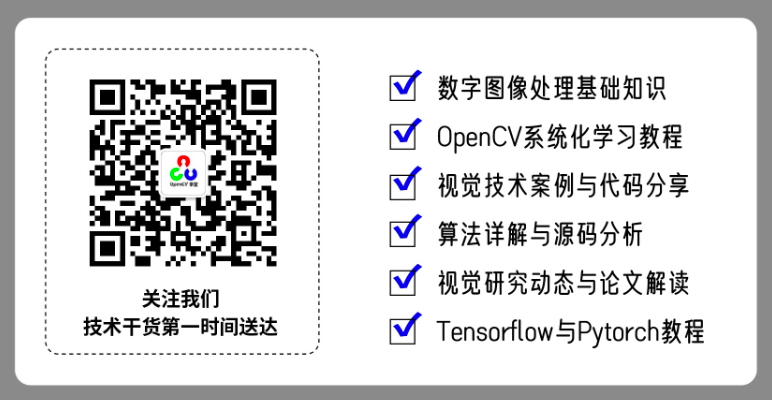
Click the blue words above to follow us
WeChat Official Account:OpenCV Academy
Follow to get more knowledge on computer vision and deep learning
Content and Features of this Book
All source code in the book has been debugged with OpenCV4.8 + VS2017. To purchase this book, please scan the QR code (the link is currently discounted!)

Table of Contents
Part One: Basics
Chapter 1: Introduction to OpenCV and Installation
1.1 Introduction to OpenCV
1.1.1 History of OpenCV
1.1.2 OpenCV Modules and Functions
1.1.3 Milestones of OpenCV4
1.1. Current Status and Development Trends of OpenCV Applications
1.2 OpenCV Source Code Project
1.3 Building OpenCV4 Development Environment
1.4 Your First OpenCV Development Program
1.5 Loading and Saving Images
1.5.1 Loading Images
1.5.2 Saving Images
1.6 Loading Videos
1.7 Summary
Chapter 2: Mat and Pixel Operations
2.1 Mat Objects
2.1.1 What is a Mat Object?
2.1.2 All Data is Mat
2.1.3 Mat Types and Depths
2.1.4 Creating Mat Objects
2.2 Pixel Access
2.2.1 Traversing Pixel Data in Mat
2.2.2 Pixel Arithmetic Operations
2.2.3 Bitwise Operations
2.2.4 Adjusting Image Brightness and Contrast
2.3 Image Types and Channels
2.3.1 Image Types
2.2.2 Image Channels
2.2.3 Channel Operations
Chapter 3: Color Space
3.1 RGB Color Space
3.2 HSV Color Space
3.3 Lab Color Space
3.4 Color Space Conversion and Applications
3.5 Summary
Chapter 4: Image Histogram
4.1 Pixel Statistical Information
4.2 Histogram and Plotting
4.3 Histogram Equalization
4.4 Histogram Comparison
4.5 Histogram Back Projection
4.6 Summary
Part Two: Advanced
Chapter 5: Convolution Operations
5.1 Concept of Convolution
5.2 Convolution Blur
5.3 Custom Filtering
5.4 Gradient Extraction
5.5 Edge Detection
5.6 Noise and Denoising
5.7 Edge Preserving Filtering
5.8 Sharpening Enhancement
5.9 Summary
Chapter 6: Binary Images
6.1 Image Thresholding Operations
6.2 Global Threshold Segmentation
6.3 Adaptive Threshold Segmentation
6.4 Denoising and Binarization
6.5 Summary
Chapter 7: Binary Analysis
7.1 Overview of Binary Image Analysis
7.2 Connected Component Labeling
7.3 Contour Detection
7.4 Contour Measurement
7.5 Fitting and Approximation
7.6 Contour Analysis
7.7 Line Detection
7.8 Circle Detection
7.9 Maximum Inscribed Circle and Minimum Circumscribed Circle
7.10 Contour Matching
7.11 Maximum Contour and Keypoint Encoding
7.12 Convex Hull Detection
7.13 Summary
Chapter 8: Morphological Analysis
8.1 Overview of Image Morphology
8.2 Erosion and Dilation
8.3 Opening and Closing Operations
8.4 Morphological Gradient
8.5 Top Hat and Black Hat
8.6 Hit or Miss
8.7 Structuring Elements
8.8 Distance Transform
8.9 Watershed Transform
8.10 Summary
Chapter 9: Feature Extraction
9.1 Image Pyramids
9.1.1 Gaussian Pyramid
9.1.2 Laplacian Pyramid
9.1.3 Pyramid Fusion
9.2 Harris Corner Detection
9.3 Shi-Tomasi Corner Detection
9.4 Subpixel Level Corner Detection
9.5 HOG Features and Usage
9.5.1 HOG Feature Description
9.5.2 Pedestrian Detection Based on HOG Features
9.6 ORB Feature Descriptor
9.6.1 Keypoint and Descriptor Extraction
9.6.2 Descriptor Matching
9.7 Feature-based Object Detection
9.7.1 Homography Transformation
9.7.2 Object Detection
9.8 Summary
Chapter 10: Video Analysis
10.1 Color-based Object Tracking
10.2 Video Background Analysis
10.3 Frame Difference Method Background Analysis
10.4 Sparse Optical Flow Analysis
10.5 Dense Optical Flow Analysis
10.6 Mean Shift Analysis
10.7 Summary
Chapter 11: Machine Learning
11.1 KMeans
11.1.1 KMeans Image Segmentation
11.1.2 KMeans Extracting Image Color Palette
11.2 KNN Classification
11.3 SVM Classification
11.4 HOG+SVM Custom Object Detection
11.5 Summary
Part Three: Advanced and Practical
Chapter 12: Deep Neural Networks
12.1 Overview of DNN
12.2 Image Classification
12.3 Object Detection
12.3.1 SSD Object Detection
12.3.2 Faster-RCNN Object Detection
12.3.3 YOLO Object Detection
12.4 ENet Image Segmentation
12.5 Style Transfer
12.6 Scene Text Detection
12.7 Face Detection
12.8 Summary
Chapter 13: Custom Object Detection with YOLOv5
13.1 Download and Install YOLOv5
13.2 Pre-trained YOLOv5 Model Object Detection
13.3 Custom Object Detection
13.3.1 OID Dataset Download and Preparation
13.3.2 Configuration File Modification and Training
13.3.3 Deploying Custom Object Detection Model
13.4 Summary
Chapter 14: Defect Detection
14.1 Defect Detection in Simple Backgrounds
14.1.1 Problem Description
14.1.2 Binary Analysis
14.1.3 Defect Analysis
14.2 Defect Detection in Complex Backgrounds
14.2.1 Frequency Domain Enhanced Defect Detection
14.2.2 Spatial Domain Enhanced Defect Detection
14.2.3 Summary
14.3 Case Study – Blade Defect Detection
14.4 Deep Learning-based Defect Detection
14.4.1 Classification-based Defect Detection
14.4.2 UNet-based Defect Detection
14.5 Summary
Chapter 15: OpenVINO Acceleration Support
15.1 Installing and Configuring OpenVINO Framework
15.1.1 OpenVINO Installation
15.1.2 Configuring C++ Development Support
15.2 OpenVINO 2022.x SDK Inference Demonstration
15.2.1 Inference SDK Introduction
15.2.2 Inference SDK Demonstration
15.3 OpenVINO Support for UNet Deployment
15.4 OpenVINO Support for YOLOv5 Deployment
15.5 Summary
Chapter 16: CUDA Acceleration Support
16.1 Compiling OpenCV CUDA Version
16.2 CUDA Accelerated Traditional Image Processing
16.2.1 Conversion between Mat and UMat
16.2.2 CUDA Accelerated Version of Video Background Analysis
16.3 CUDA Accelerated OpenCV DNN
16.4 Summary
Q&A and Services
The book contains a total of 16 chapters, focusing on detailed explanations of commonly used OpenCV development modules and engineering development practices, enhancing OpenCV application development capabilities, helping readers become OpenCV developers, and including knowledge on deep learning model training and deployment acceleration, further expanding the skill set needed for industrial project implementation. To purchase, please click the link:
https://item.jd.com/10092255924058.html
The learning course has a dedicated Q&A group
Responsible for personalized Q&A
Exclusive QQ Group for Readers: 657875553
Group Entry Code: OpenCV4 Reader
